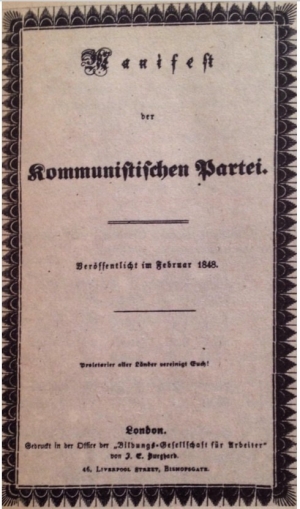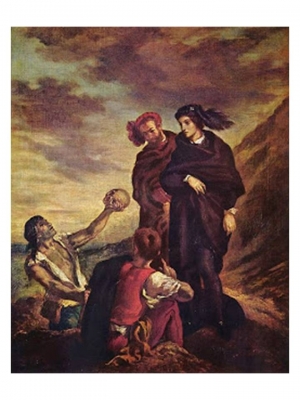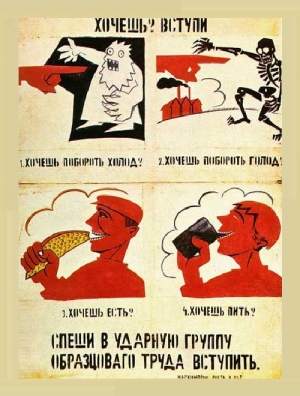
......and its name is Communism
On the 170th anniversary of the publication of the Communist Manifesto, Jenny Farrell introduces Brecht’s poetic re-writing of the Communist Manifesto, with its ‘spectre of communism, which continues to be a threat to the rulers and a friend to the damned of the earth.’
In February 1848, Marx and Engels published “The Communist Manifesto” (TCM). It remains to this day a remarkable piece of literature, a lucid and powerful explanation of politics, economics and culture. It outlines the central importance of class in understanding human history, and a programme to guide our struggle for a more humane, communist society with no class-based divisions.
Almost one hundred years after its first publication, on 11 February 1945, German communist poet and playwright Bertolt Brecht noted in his diary the plan to re-write this text in verse. He was still living in exile in Santa Monica. The end of WWII was approaching and with it the question concerning the future of Germany. Brecht recorded in his journal on 10 March1945: “terrible newspaper reports from Germany. Ruins and no sign of life from the workers”.
Brecht hoped to infuse the original text with “new, armed authority”. The past century had witnessed ever-deeper crises and two horrendous wars. It had also seen for the first time in history a successful revolution, in which the proletariat had taken power. Armed with this historical perspective, the awareness of later Marxist theory, and the need to revive the idea of communism as the only alternative to barbarism, Brecht resolved on this spectacularly ambitious challenge.
With Lucretius’s didactic poem De rerum natura (On the Nature of Things) in mind, and the added challenge of hexameters, he began writing a didactic poem “On the Abnormality (Un-nature) of Bourgeois Relations”. At the heart of four intended cantos, two were to be a versification of the Manifesto, plus an initial one on the difficulties of understanding the nature of society, and a final one to demonstrate the monstrous increase in barbarism. Brecht wrote the second canto first, versifying the first chapter of TCM. This is the only part that Brecht worked on and fully developed. However, Brecht did not publish it during his lifetime, and the poem remained a fragment. Yet “The Manifesto” is awe-inspiring and truly memorable.
In his versification, Brecht follows the original text, often using its terms and famous formulations, but changing some of these around in the interest of dramatic effect and also modernising it. Take the opening stanza: TCM famously begins: “A spectre is haunting Europe – the spectre of communism”. Brecht uses the phrase “A spectre is haunting” in the opening line, and marvellously personifies it as present in various places and situations around the world. He withholds the name of the personified spectre until the end of the stanza, creating an arc of tension and adding dramatic emphasis to the word “Communism”.
Here is an extract, translated by Jack Mitchell:
Wars ruin the world and a spectre is haunting the ruins.
Not born in war, seen around in peace too, for some time now.
Nightmare to rulers but friend to the children that live in the townships.
Shaking its head as it peers into half-filled plates in poor kitchens.
Standing in wait then for those that are weary at pit-head and yard-gate.
Visiting friends in the prisons, passing in without pass-card.
Seen even in offices, heard in the lecture-halls, personally
Sometimes mounting giant tanks and flying in death-dealing bombers.
Speaking in various tongues, in all tongues. Keeping silent in many.
Guest of honour in ghettos and slums, the terror of palaces
Some here to stay, and for ever: its name is Communism.
Apart from its friendly and ever-present character, Brecht stresses the fear “palaces” have of the spectre, and its willingness to defend itself. The new world situations enter into the image as the spectre mounts tanks and death-dealing bombers, referring to the Soviet army in WWII defending the Soviet Union from Nazi invasion.

The difference between the original text and its poetic ‘translation’ is evident in the gentleness with which Brecht describes the spectre’s actions: vivid actions take the place of theoretical explanation. This is not a judgement of better or worse, it is a comment on the specific nature of art and poetry. Art and poetry capture the nature of the world and of society in specific, individualised images, whereas a text like TCM aims to outline some general principles of history and society. Although it occasionally illustrates its points with references to art, it operates on a different, more abstract level.
Another way in which Brecht departs from the original is that he addresses his readers directly. He also establishes the speaker as intermediary between the reader and the founders of scientific communism:
Much you’ve heard tell of it. This, however, is what its founders say.
If you read history you read of the deeds of immense individuals;
Their star, in its rising and falling; the march of their armies;
Or of the pomp and destruction of empires. For them, for the founders
However, history is foremost the history of conflicts of classes.
They see the peoples internally split into classes and
Warring within. Patricians and knights, plebeians and slaves
Nobles, peasants and craftsmen, proletarians and bourgeois today
Keep in their turn the whole mighty household in motion, creating
And distributing the goods that are needed for living, but also
Fighting their fight to the death, the old fight, the one for dominion.
A central theme in TCM are the modes of production, and production itself. While Marx describes the objective laws of capitalist production, Brecht invests his imagery with the sense of natural laws. While Marx presents facts and outcomes, Brecht focuses on activities:
Never before was unleashed such a wild surge of creation
As that which the bourgeoisie in its epoch of sway has unfolded
One which bowed nature to man and made steam and electrical power
Cleared rivers for shipping and continents ready for tillage.
Never before had humanity guessed that asleep in its womb
Such liberations were lurking and powers of production like these.
Overproduction in capitalism, leads to its reversal, the destruction of commodities. The following quote is from the translation by Darko Suvin (see endnote):
Immemorial hunger had plagued the world when granaries emptied:
Now, nobody knows why, we’re hungry when they’re too full.
Mothers find nothing in the bare pantry to fill the small mouths
While sky-high mountains of grain rot behind walls.
& while bales upon bales of cloth are warehoused, the ragged family,
Overnight kicked out of its rented home, wanders freezing
Through emptied city quarters.
He illustrates the commodity nature of all labour:
Just as the capitalist sells his commodities, likewise the worker
Sells his commodity, namely his labour-power, being subjected
Therefore to competition and all the ups and downs of the market.
Appendage merely to the machine he sells his simple knack
Costing no more than the cost of his keep and whatever little he needs to
Reproduce and bring up his kind, that most useful of species
Since labour-power’s price, like the price of all other commodities
Depends on its cost of production. Out of the tiny workshop of old
Handicraft grew the great factory ordering army-wise
Work and the workers, slaves of the bourgeois state but also
Slaves of a certain bourgeois, his overseers and the machine.
He highlights the way capitalist production dehumanises:
Instead of feeding off
Its proletarians, now it must feed them. It needs to employ them
But has no employment for them and yet lets their numbers swell.
And dehumanization wins, marking the victims
and victimizers….
He also draws on other, later works of Marx, including for example the theory of cyclical crises and the hidden fetishism of commodity economy, adding this to the Manifesto.
The house does not exist for dwelling, the cloth for dressing
Nor the bread for stilling hunger: they must bring Profit.
If the product however is only used, but not also bought
Since the producer’s pay is too small – were the salary raised
It wouldn’t pay to produce the commodity – why then
Hire the hands? For they must produce at the workbench more
Than a reproduction of worker & family if there’s to be
Profit! Yet what then with the commodities? In good logic therefore:
Woolens and grain, coffee and fruits and fish and pork
All are consumed by fire, to warm the God of Profit!
Heaps of machines, tools for entire armies of workers,
Blast furnace, shipyard and mine and iron and textile mill
All sacrificed, cut up to appease the God of Profit!
Yet their God of Profit is smitten with blindness. He never sees
The victims. He’s ignorant. While he counsels believers he mumbles
Formulas nobody grasps.
Note how specifics evoke all the senses and make the images more memorable: “Woolens & grain, coffee and fruits and fish and pork” appeal to our senses of touch, smell, taste and vision. “Blast furnace, shipyard and mine and iron and textile mill” add red heat, the contrasting coolness and paler colour of the sea, the darkness and depth of the mines, the women and children of the textile mills, the sounds of industry.

At the Coal Face. A Miner Pushing a Tub, Henry Moore, 1942
Brecht’s “The Manifesto” is not simply a reiteration of TCM in verse form. It is more than that, it is an expansion of the original based on Marxist theory. Readers in later times will bring their experience to the poem.
Now however those weapons wielded with deadly effect
To shatter the feudal world are turned on the bourgeoisie.
Yes it too has brought forth a class that will bear those death-dealing
Weapons against it, for all through the centuries, bound in its service
Grew with the bourgeoisie also the proletariat of the modern
Workers, living by labour and finding work only so long as they
Work in the bourgeois interest, increasing his capital interests.
Just as the capitalist sells his commodities, likewise the worker
Sells his commodity, namely his labour-power, being subjected
Therefore to competition and all the ups and downs of the market.
Appendage merely to the machine he sells his simple knack
Costing no more than the cost of his keep and whatever little he needs to
Reproduce and bring up his kind, that most useful of species
Since labour-power’s price, like the price of all other commodities
Depends on its cost of production. Out of the tiny workshop of old
Handicraft grew the great factory ordering army-wise
Work and the workers, slaves of the bourgeois state but also
Slaves of a certain bourgeois, his overseers and the machine.
“The Manifesto” saw a number of re-workings. Upon his return to Berlin, Brecht went back to the draft several times. Communist composer and fellow exile in the US, Hanns Eisler, later regretted the fact that he and Feuchtwanger had discouraged Brecht in this project. He said:
If we had an epic by Brecht, “The Communist Manifesto”, then this would have gone down in human history as a very rare work of art indeed. (…) we did not consider then that Marxism must be disseminated in many ways, in many areas and in manifold subtleties. (…) much becomes attractive by being poeticised, that is deemed boring in the flatness of everyday life, the difficulties of class struggle, or academic classrooms. Brecht casts a golden sheen.
The world-famous spectre that Marx described so clearly still haunts the world, wherever wars devastate innocent populations, man-made famine stalks poor countries, workers are paid poverty wages, and the powerful oppress the dispossessed. The spectre explains the reasons for such devastation and oppression. It speaks in countless languages, and is expressed in many cultural activities – sport and religion as well as all the arts. Those cultural activities are also the site of continuous struggle, throughout history, as ruling classes seek to control and manipulate them, and veil or corrupt their fundamentally social, co-operative nature in order to obtain consent and maintain social order, so that economic exploitation can proceed unchallenged.
Yet still people fight back, economically, politically and culturally. In short, the spectre of communism continues to be threat to the rulers and a friend to the damned of the earth:
Therefore the one class capable of defeating the bourgeoisie
And shattering the fetter its state has meanwhile become
Is, in our time, the working class. It is this by its size and condition.
All that once guaranteed life in the older society now is
Rubbed out, done away with, in the life of the proletariat.
Propertyless, head and provider no longer to wife and children
Hard to distinguish by nation or native place now, for the selfsame
Subjection at the selfsame machine marks him from Essen to Canton
Morals and religion confront the proletarian as fata morganas
Mirroring to him, far off unattainable, Edens in deserts.
/…/
His is the movement of the immense majority, and his dominion is
Domination no more but the subjection of all domination.
There oppression alone is oppressed for the proletariat must
As society’s undermost stratum, in rising, completely demolish
The social set-up entire with all its uppermost strata.
It can shake off its subjection only in shaking off all
Subjection from all people.
Works consulted:
Rita Schober, "Brechts Umschrift des Kommunistischen Manifests" in Vom Sinn oder Unsinn der Literaturwissenschaft, Mitteldeutscher Verlag Halle Leipzig, 1988.
Hans Runge, "Das Manifest" von Bertolt Brecht, Sinn und Form, Heft 2-3, 1963.
Robert Spaethling, "Bertolt Brecht and the Communist Manifesto", The Germanic Review, Columbia University Press, vol. XXXVII, 1962.
Socialism and Democray online, On Brecht’s “The Manifesto”: Comments for Readers in English, April 11, 2011.
Most quotations used here are from a translation by Jack Mitchell, unpublished.
For the full text of Brecht’s poem in English, please see the translation by Darko R. Suvin 1999, 2001, accessible here.

































